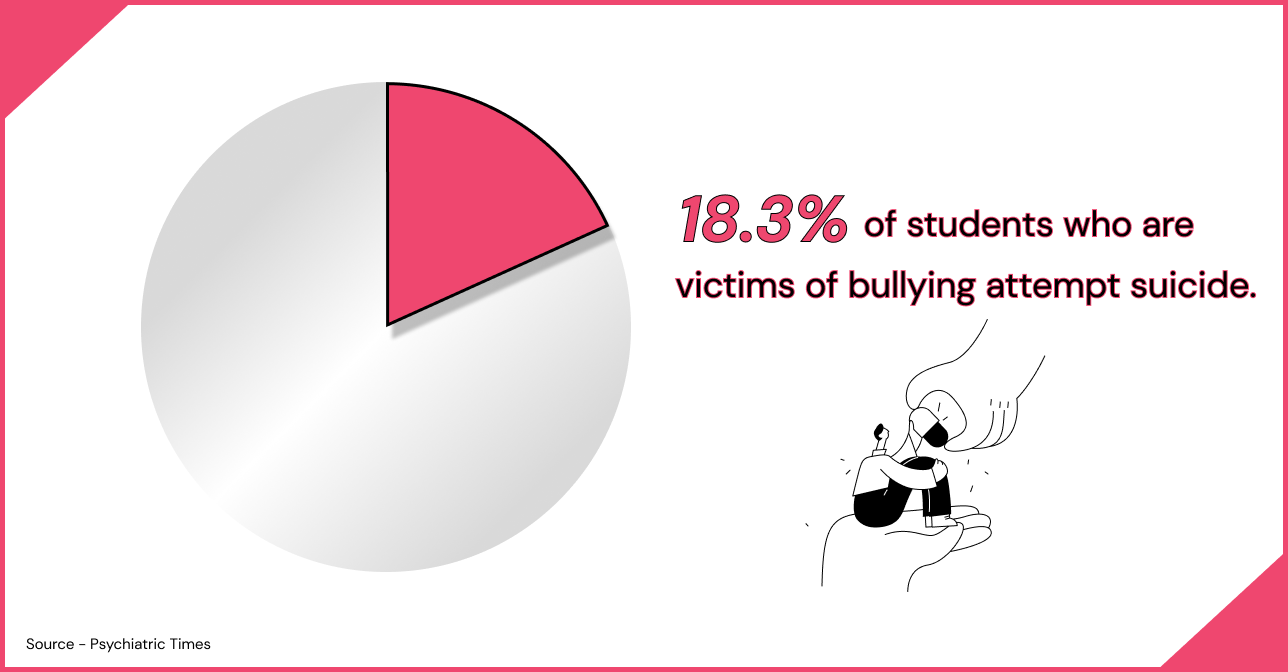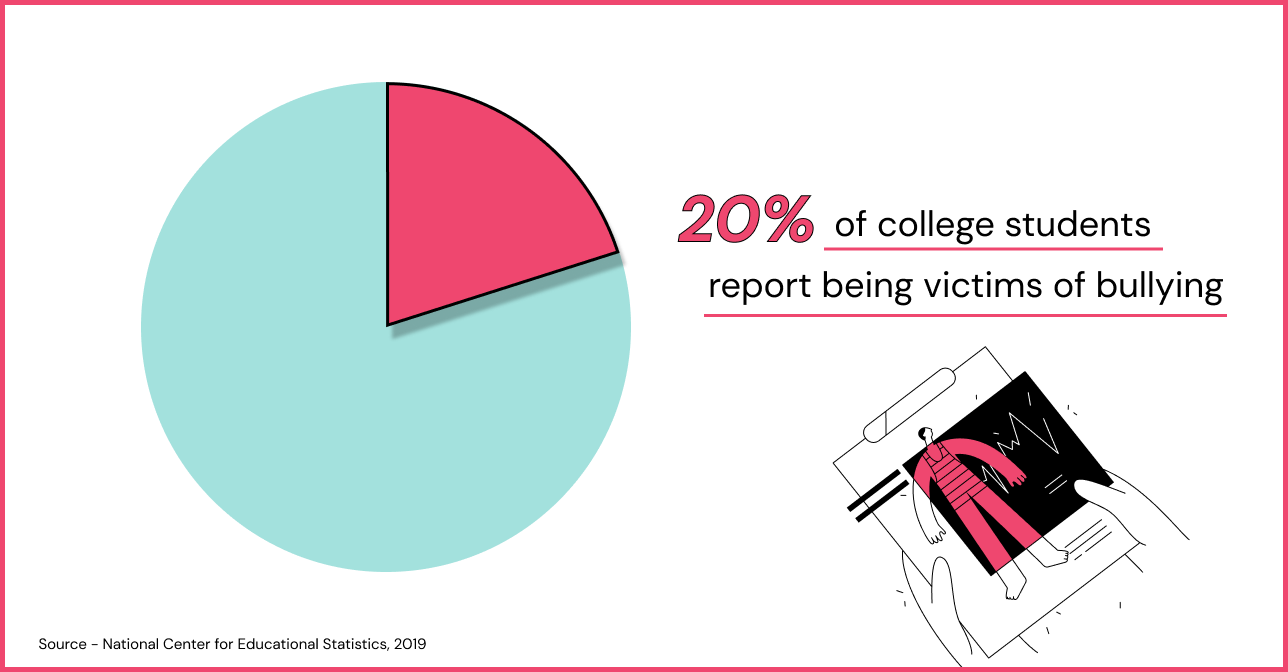Violence in any form is absolutely unacceptable, especially among children and young adults. However, the reality is that more than 20% of students report being victims of bullying. Although this percentage is lower than in previous years, it is still quite high. Today, we will discuss what is bullying in college, its consequences, and possible solutions to this pressing problem.
What Is Bullying and Cyberbullying in College?
Unfortunately, we need to face the sad truth: cyberbullying and bullying in college are commonplace. They poison campuses and can cause detrimental consequences for students. The National Center Against Bullying defines bullying as follows: “It is a sustained psychological or physical abuse by one person (or group of people) against another person (or group of people). Such actions are purposefully done to cause physical, social, and/or psychological harm.”
Abusive behavior in college can take many forms. It can manifest as verbal abuse, social exclusion, physical intimidation, or emotional manipulation. Unlike high school, where learners constantly engage with the same peers, colleges have a larger and more diverse community. This only encourages further campus bullying when such incidents are left unaddressed or go wholly unnoticed.
Forms of college bullying may include:
- Academic bullying involves spreading rumors, sabotaging work, or manipulating group projects. These actions negatively affect a student’s academic performance.
- Social bullying is expressed in exclusion, gossip, or manipulation within friend groups or social circles.
- Hazing causes emotional distress or physical harm to young people.
Cyberbullying is a form of harassment that has grown into a separate serious threat. It “blooms” in the open spaces of social media platforms, messaging apps, and online forums.
Cyber bullying in colleges might involve:
- Online harassment. Students might face abuse, threats, or humiliation when using various online platforms.
- Social media shaming. Young people can experience public humiliation through the sharing of personal photos, videos, or comments without permission.
- Impersonation. Bullies can use fake profiles to damage a student’s relationships or reputation on campus.
The role of technology in cyberbullying: Is there bullying in college?
The massive digitalization of all parts of everyday life has both advantages and disadvantages. In the context of cyberbullying, it looks as follows. On the one hand, technology has made it possible for people to communicate at a distance to keep in touch with loved ones. On the other hand, this same technology enabled many individuals to use online platforms with malicious intent.
To dive deeper into the role of technology in the widespread phenomenon of cyber bullying in colleges, we must address the following aspects:
- Anonymity and distance. Criminals use anonymous or fake accounts to abuse the victim without revealing their true identity. Anonymity inspires them to behave in ways they would not in face-to-face communication.
- Accessibility and widespread use of technology allow cyberbullying to go beyond physical boundaries. Social media platforms, messaging apps, online gaming communities, and forums are common places for online abuse. Here, people can reach their victims anytime, regardless of their location.
- The virality of content on the Internet. What goes online stays online. Digital traces are almost impossible to remove completely. That’s why, even after deleting embarrassing photos or videos, they can reappear in different places, only increasing the victim’s suffering.
The Impact of Bullying on College Students’ Well-Being
Bullying in college, whether in person or online, has a major impact on students’ mental health and overall well-being. The principal effects of bullying include the following:
- Emotional and psychological effects
The most common outcomes of bullying in college students are distress, anxiety, depression, and low self-esteem. In the worst cases, young people even attempt suicide. According to research, the percentage of such children reaches an appalling 18.3%. The constant fear, humiliation, or feelings of worthlessness from abuse prevent a student from learning and enjoying a fulfilling school experience.
- Academic impact
Students who are bullied often can’t focus on their studies, which leads to poor academic performance and an overall lack of motivation to go to school.
- Physical health consequences
Bullying’s effects are not limited to mental health; they can also manifest themselves in physical health problems. Continuous harassment and the stress it causes can lead to headaches, stomach problems, sleep disorders, and more.
- Long-term effects
The effects of bullying in college are not limited to the years of study. Researchers confirm that young people who have experienced abuse at some point during their education are more likely to be depressed and struggle to form relationships as adults.
Recognizing the Signs of Bullying Among College Students
How can bullying be prevented? College bullying can be hard to detect. However, there are signs to pay attention to. The following signs may indicate that a student is being bullied.
- Changes in behavior. Sudden changes in behavior are not a good sign. People may become withdrawn, anxious, or unusually quiet.
- Physical symptoms. Bullying in college can affect a child’s health. Unexplained injuries, headaches, stomachaches, or sleeping problems can be signs of harassment.
- Lower academic performance. Abuse also negatively impacts a student’s academic progress. Changes in grades, a sudden loss of interest in learning, missing classes, or avoiding certain places on campus may indicate that they suffer from harassment.
“Is there bullying in college? Yes, there is. Recognizing the signs of bullying is absolutely crucial. Talk to the victims if you notice any of these changes in someone you know. Let them know you are there to support them and encourage them to reach out to trusted adults or college resources for help.”
Wang Shu Huang, a recent university graduate
How to intervene in bullying situations:
- If you see someone getting bullied in college, approach the situation calmly and take care of your safety. Never put yourself in danger.
- If it is safe to do so, speak out against bullying. Use confident language and make it clear that it is unacceptable.
- If the situation escalates or you don’t know how to handle it, ask for help from an adult. This could be a teacher, counselor, supervisor, or someone in a position of authority.
- Sometimes, distraction can help defuse the situation. Approach the offender and speak to them to divert attention.
- After intervening, encourage a victim to report the incident to the appropriate authorities and seek support for bullying victims.
Legal and institutional responses to bullying prevention
Is there bullying in college? Unfortunately, yes. In recent years, recognizing its serious impacts has led to the establishment of measures addressing and preventing bullying among children. All 50 states have anti-bullying laws. Such regulations require schools to report, document, and investigate abuse within a certain number of days. As for the schools themselves, their charters usually clearly state what exactly is meant by bullying, the mechanisms they offer to respond to it on campus, and the educational work they do in this area.
Strategies for Preventing Bullying in College
While bullying wrecks the mental and physical health of students in college, all participants in the educational process have no right to stand by. Only by implementing effective strategies for bullying prevention can this shameful practice be rooted out.
Effective strategies for building a supportive college community without bullying
Colleges can take the following steps to prevent bullying:
- Development of a comprehensive anti-bullying policy. Every educational institution ought to have a clear anti-bullying policy that defines what is considered bullying and outlines the consequences of such actions. All students, staff, and faculty should know about the preventing bullying policy.
- Fostering awareness and education. Colleges and universities must organize abuse awareness campaigns, seminars, and training to educate the campus community. These activities should promote empathy, respect, and understanding of diversity among students and staff.
- Cultivating a culture of support. School authorities must forge a culture of support and inclusivity where everyone feels valued and respected. They should also encourage students to speak out against bullying and help students getting bullied in college.
- Strengthening supervision and intervention. How can bullying be prevented? College administrations must provide increased supervision in common areas, such as cafeterias, hallways, and recreational areas, where harassment is most likely to happen. All faculty and staff members, in turn, should know the signs of bullying and intervene effectively when necessary.
“Implementing anti-bullying strategies can create a safer and more supportive college environment.”
Leticia Adamson, Ph.D. in English Literature and ESL Program Head at CustomWritings.com
Resources and Support for Victims of College Bullying
If a student is a victim of bullying in any form, they should definitely seek help. The first step is to contact the school authorities so that the incident is not ignored and the offenders are punished. In addition to getting help from the college, they can also use anti-bullying resources below.
- Bully Bust: Center for Social and Emotional Education. The program is administered by The National School Climate Center (NSCC). The organizers of the initiative focus their efforts on educating students and adults to combat bullying in college.
- StopBullying.gov. This government program concentrates on battling harassment through educational work and support for bullying victims.
- Cyberbullying Research Center. The center regularly educates young people about the rules of safe online communication, dating, social media, and campus bullying in general.
FAQ
- What defines bullying and cyberbullying in a college setting?
Bullying is repeated aggressive behavior to hurt or intimidate someone. In college, it can take the form of verbal abuse, threats, physical intimidation, or manipulation.
Cyberbullying is the use of social media, texting, or online platforms to harass, intimidate, or humiliate someone. In college, it can include spreading rumors, posting hurtful comments, sharing embarrassing photos or videos, or creating fake profiles to harass a student. - How can one recognize if a college student is being bullied?
One can recognize the signs of bullying among college students by witnessing changes in behavior, mood, or academic performance. These can include avoiding social activities, anxiety, depression, sudden changes in academic performance, unexplained physical injuries, or unwillingness to attend classes or participate in activities. - What are the effects of bullying on college students?
The effects of bullying on college students can include deep emotional distress, anxiety, depression, low self-esteem, lower academic performance, and worsened overall well-being.






